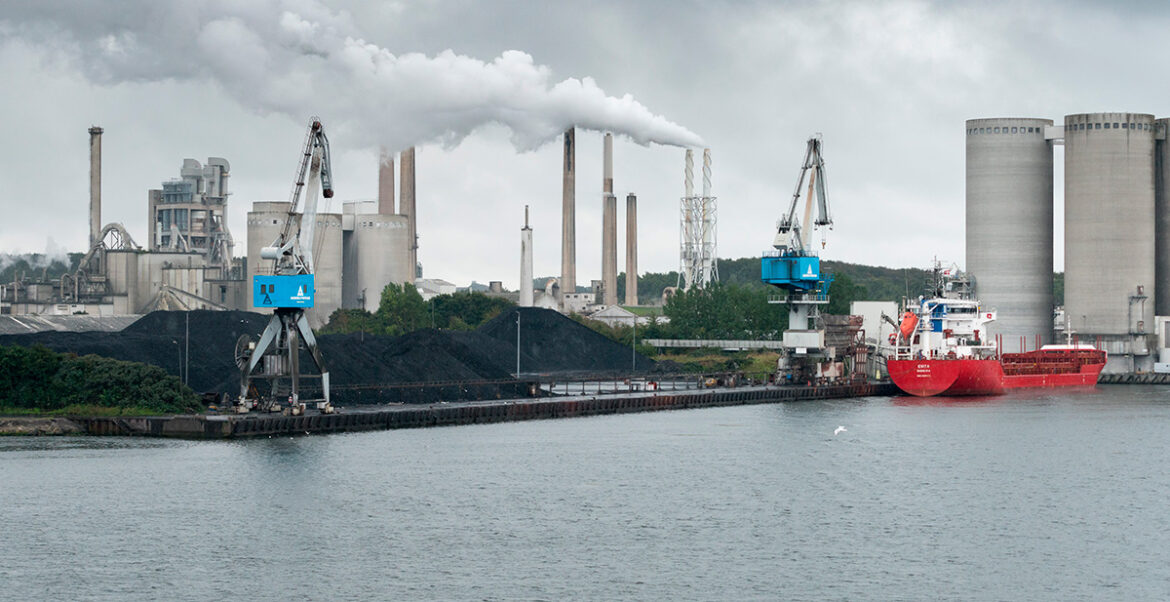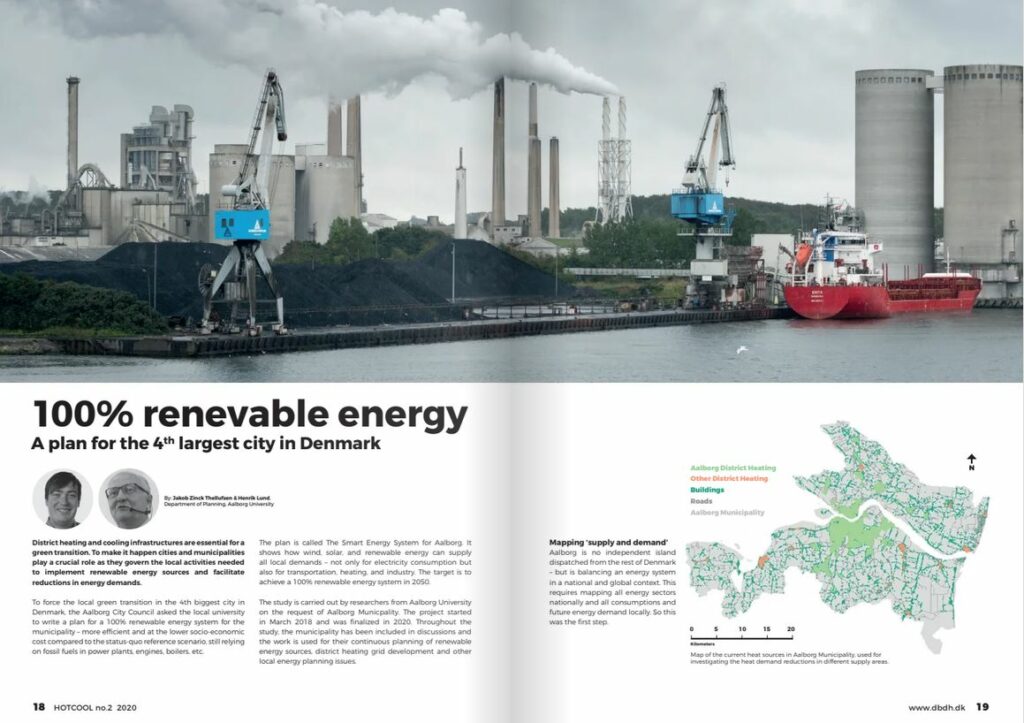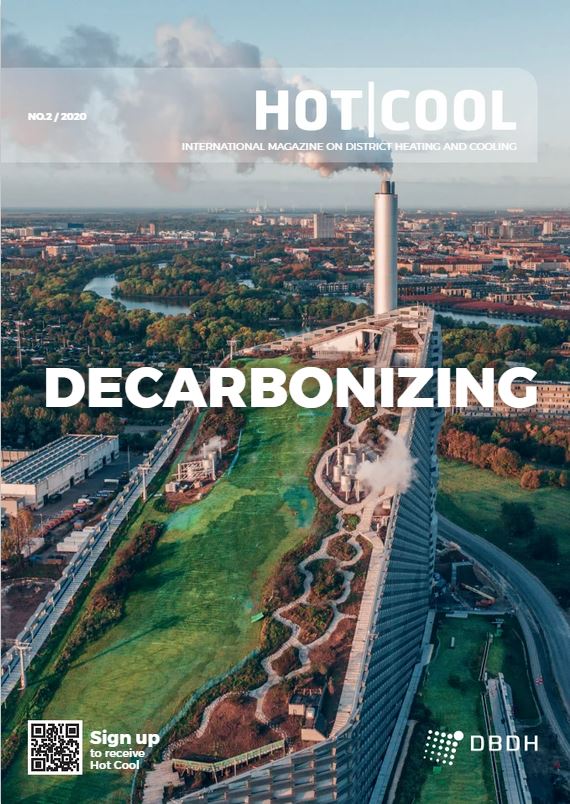District heating and cooling infrastructures are essential for a green transition. To make it happen, cities and municipalities play a crucial role as they govern the local activities needed to implement renewable energy sources and facilitate reductions in energy demands.
By Jakob Zinck Thellufsen & Henrik Lund , Department of Planning, Aalborg University
To force the local green transition in the 4th biggest city in Denmark, the Aalborg City Council asked the local university to write a plan for a 100% renewable energy system for the municipality – more efficient and at a lower socio-economic cost compared to the status quo reference scenario, still relying on fossil fuels in power plants, engines, boilers, etc.
The plan is called The Smart Energy System for Aalborg. It shows how wind, solar, and renewable energy can supply all local demands – not only for electricity consumption but also for transportation, heating, and industry. The target is to achieve a 100% renewable energy system in 2050.
The study is carried out by researchers from Aalborg University at the request of Aalborg Municipality. The project started in March 2018 and was finalized in 2020. Throughout the study, the municipality has been included in discussions, and the work is used for their continuous planning of renewable energy sources, district heating grid development, and other local energy planning issues.
Mapping ‘supply and demand’
Aalborg is no independent island dispatched from the rest of Denmark – but is balancing an energy system in a national and global context. This requires mapping all energy sectors nationally
and all consumptions and future energy demand locally. So, this was the first step.
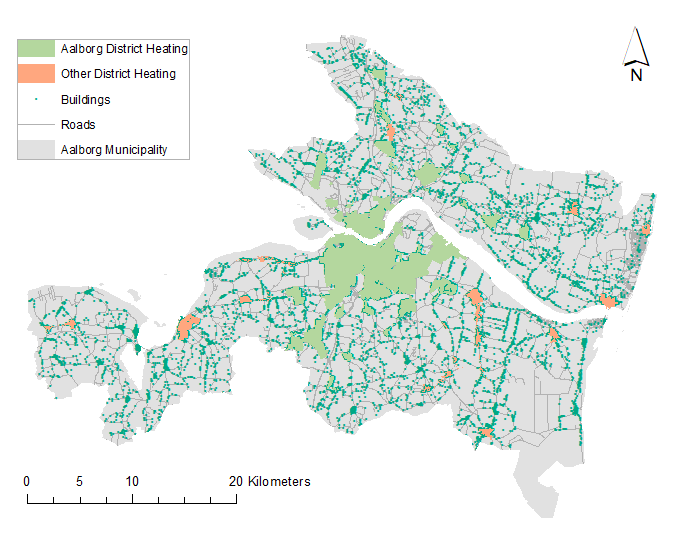
Map of the current heat sources in Aalborg Municipality, used for investigating the heat demand reductions in different supply areas.
Identifying energy demands now – and for the future
For identifying heating demands, a local geographic analysis mapping district heating, individual boilers, and heat pumps was made. The analysis included energy efficiency measures and the costs of implementing energy savings in buildings.
For identifying the future energy demands for industry, transportation, and electricity the consumption of today was mapped. Then, it was scaled based on the Danish expectation for future energy demands identified in the IDA Energy Vision 2050.
Identifying energy supply now and green energy for the future
Balancing energy supply and demand for electricity, industry, and transportation on a national scale is, of course, a national matter. However, Aalborg has to level local industry demands with local supply as local industries may be un-proportional in size and energy consumption.
For Aalborg to balance the local and national energy supply, the next step was to identify and qualify local and national energy supply sources.
Biomass
For green transition, biomass is very relevant. Under the right circumstances, biomass for incineration is CO2-neutral. But it is a limited resource, too. Overutilization of biomass in Aalborg can set a limit for other cities to begin an easy renewable energy transition by biomass incineration.
The Smart Energy System for Aalborg suggests a 25 GJ/person energy supply from biomass similar to the level identified in The Danish Society of Engineers, IDA Energy Vision.
Wind and solar
Aalborg Municipality has several possible locations for wind turbines, as well as rooftops and land areas to support local solar PV installations. Most of the electricity can be sustainable and locally produced. This means more of Denmark’s large offshore wind capacity can be used in the Copenhagen area, with no space for land turbines.
The benefits of system integration and energy storage
The Smart Energy System for Aalborg is a cost-efficient renewable energy system integrating all energy sectors.
The electricity produced by wind turbines and solar cells is directed not only to the electricity sector but also to transportation, heating, and fuel demands in industry and heavy-duty transport. By doing this, it is possible to use variable electricity more flexibly due to various demand profiles and the accessibility to cheap storage.
Storing energy as hot water, gas, or liquid fuel is much cheaper than storing it as electricity. However, to gain this cost-benefit, it is necessary to utilize the hot water in district heating, the gas in industry and thermal plants, and the liquid fuel in heavy-duty transport, shipping, and aviation.
As the Sankey diagram illustrates, all these couplings are used in the Aalborg Energy Vision. Electricity is converted to hot water through heat pumps and electric boilers to be utilized in the district heating network. Here, thermal storages are utilized so more heat can be produced when the sun is shining and the wind is blowing – to be used later.
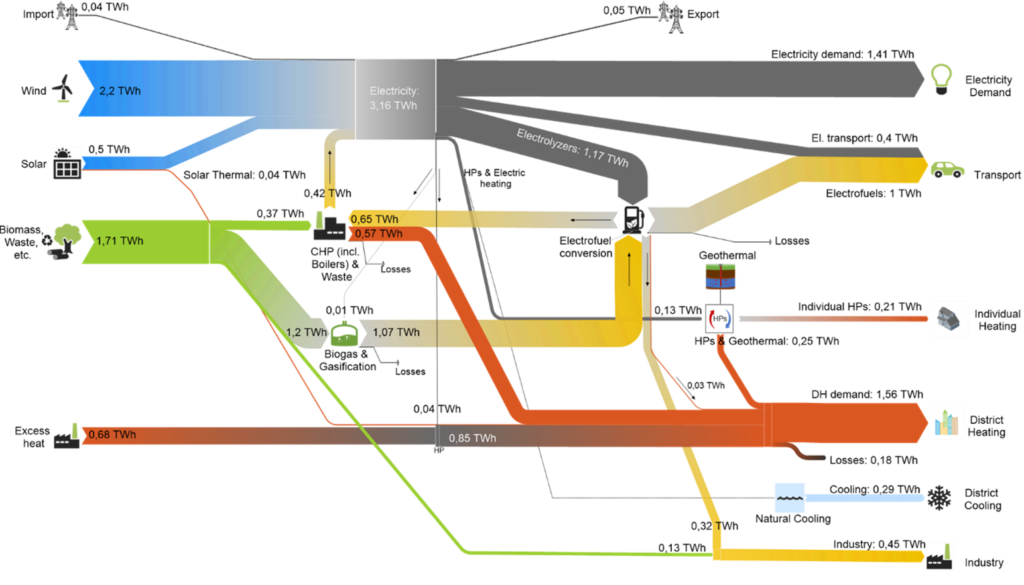
Sankey diagram illustrating the energy flows from supply to demand in the smart energy vision for Aalborg Municipality in 2050
For fuel production, electrolyzers produce hydrogen which can be stored short term in hydrogen storage, but else is converted into fuel or gas to be used in industry, peak load power plants, or the transport sector. Finally, the wind is also integrated into the transportation sector through electric vehicles. These are smart charged, so they better fit with low-demand hours from other electricity demands and hours with large wind and solar energy production.
Low-temperature district heating and excess heat utilization
A low-temperature fourth-generation district heating grid is implemented in the Aalborg Energy Vision, reducing supply and return temperatures. This way, it is possible to increase the efficiency of the district heating heat pumps and utilize more waste heat. In Aalborg, a large cement industry, Aalborg Portland, already delivers a substantial amount of excess heat to the district heating grid.
In the Aalborg Energy Vision, the total excess heat from industry increases from 340 GWh to 640 GWh, supplying almost half the heating demand in Aalborg Municipality.
Furthermore, the electrolyzers and electro-fuel production also produce excess heat, bringing the total up to 850 GWh. To utilize surplus heat in this scale, season storage is implemented, for accumulating surplus heat in the summer period to be used during the winter period with larger heat demands.
By combining surplus heat from the industry and using heat pumps and storage, it is possible to supply 1100 GWh of heat, which is 70% of the demand. The rest is covered by CHP (combined heat and power) running on green gas. The green gas is either biogas or synthetic methane produced from a carbon source and hydrogen.
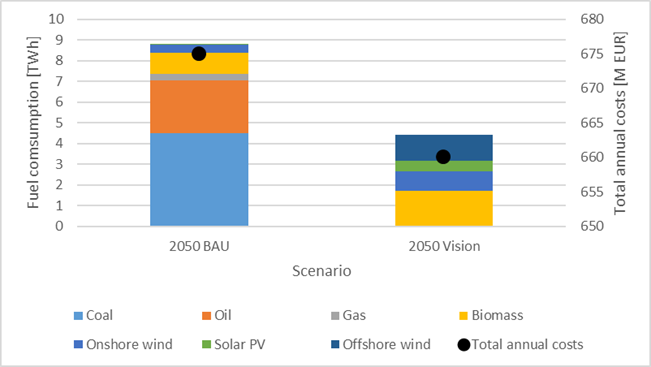
Comparison of the fuel consumption and total annual costs in ‘the business as usual scenario’ versus ‘the 2050 smart energy vision’ for Aalborg Municpality
References
J. Z. Thellufsen, H. Lund, P. Sorknæs, P. A. Østergaard, M. Chang, D. Drysdale, S. Nielsen, S. R. Djørup, K. Sperling, Smart energy cities in a 100% renewable energy context, Renewable and Sustainable Energy Reviews, Volume 129, May 2020, https://doi.org/10.1016/j.rser.2020.109922
S. Djørup, K. Sperling, S. Nielsen, P. A. Østergaard, J. Z. Thellufsen, P. Sorknæs, H. Lund, D. Drysdale: District Heating Tariffs, Economic Optimisation and Local Strategies during Radical Technological Change, Energies, Vol 13, Issue 5, March 2020, https://doi.org/10.3390/en13051172
S. Nielsen, J. Z. Thellufsen, P. Sorknæs, S. R. Djørup, K. Sperling, P. A. Østergaard, H. Lund: Smart Energy Aalborg: Matching End-Use Heat Saving Measures and Heat Supply Costs to Achieve Least Cost Heat Supply, International Journal of Sustainable Energy Planning and Management, January 2020. https://doi.org/10.5278/ijsepm.3398
For further information please contact: Henrik Lund, lund@plan.aau.dk
